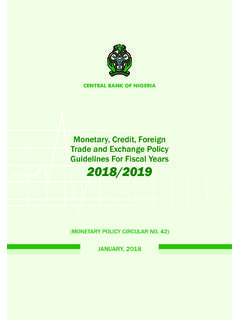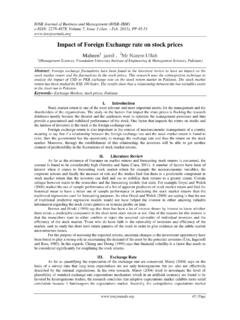Transcription of Introduction of Joint Venture (JV) - Path To China
1 Introduction of Joint Venture (JV)A Joint Venture is a business arrangement in which the participants create a new businessentity or official contractual relationship and share investment and operation expenses,management responsibilities, and profits and Chinese authorities encourage foreign investors to use this form of company in order toobtain exposure to advanced technology and new management skills. In return, foreigninvestors can enjoy low labour costs, low production costs and a potentially large Chinesemarket share. Joint Ventures are sometimes the only way to register in China if a certainbusiness activity is still controlled by the government. Restaurants, Bars, Building andConstruction, Car Production, Cosmetics etc. There are 2 types of Joint Venture :1-EJV(Equity Joint Venture )Equity Joint ventures are the second most common manner in which foreign companiesenter the China market and the preferred manner for cooperation where the Chinesegovernment and Chinese businesses are concerned.
2 Joint ventures are usually establishedto exploit the market knowledge, preferential market treatment, and manufacturingcapability of the Chinese side along with the technology, manufacturing know-how, andmarketing experience of the foreign operation of a Joint Venture is limited to a fixed period of time from thirty to fiftyyears. In some cases an unlimited period of operation can be approved, especially when thetransfer of advanced technology is involved. Profit and risk sharing in a Joint Venture areproportionate to the equity of each partner in the Joint Venture , except in cases of a breachof the Joint Venture holdings in a Joint Venture are usually non-negotiable and cannot be transferredwithout approval from the Chinese government. Investors are restricted from withdrawingregistered capital during the live of the Joint Venture contract. Regulations surrounding thetransfer of shares with only the approval of the board of directors and without approval fromgovernment authorities will probably evolve over time as the size and number ofinternational Joint ventures are specific requirements for the management structure of a Joint Venture but eitherparty can hold the position as chairman of the board of directors.
3 A minimum of 25% of thecapital must be contributed by the foreign partner(s). There is no minimum investment forthe Chinese partner(s).It is preferable that foreign exchange accounts are balanced in order to remit profits abroadso that the repatriated foreign exchange is offset by exports from the Joint Venture . Withthe elimination of foreign exchange certificates and the further opening of the China market,this requirement is becoming more and more permissible debt to equity ratio of a Joint Venture is regulated depending on the size ofthe Joint Venture . In situations where the sum of debt and equity is less than US$ 3 million,equity must constitute 70% of the total investment. In Joint ventures where the sum of thedebt and equity is more than US$ 3 million but less than US$ 10 million, equity mustconstitute at least half of the total investment. In cases where the sum of the debt andequity is more than US$ 10 million but less than US$ 30 million, 40% of the totalinvestment must be in the form of equity.
4 When the total investment exceeds US$ 30million, at least a third of the sum of the debt and equity must be can include cash, buildings, equipment, materials, intellectual property rights, andland-use rights but cannot include labor. The value of any equipment, materials, intellectualproperty rights, or land-use rights must be approved by government authorities before thejoint Venture can be : (8621) Fax: (8621) a Joint Venture is registered, the entity is considered a Chinese legal entity and mustabide by all Chinese laws. As a Chinese legal entity, a Joint Venture is free to hire Chinesenationals without the interference from government employment industries as long as theyabide by Chinese labor law. Joint ventures are also able to purchase land and build theirown buildings, privileges prevented to representative (Cooperative Joint Venture )In a Sino-Foreign Cooperative Venture (also known as Contractual Joint Venture ), theparties involved may operate as separate legal entities and bear liabilities independentlyrather than as a single entity.
5 A cooperative Venture may also be registered as a limitedliability entity resembling an equity Joint Venture in operation, structure, and status as aChinese legal is no minimum foreign contribution required to initiate a cooperative Venture , allowinga foreign company to take part in an enterprise where they preferred to remain a minorshareholder. The contributions made by the investors are not required to be expressed in amonetary value and can include excluded in the equity Joint Venture process can becontributed such as labor, resources, and services. Profits in a cooperative Venture aredivided according to the terms of the cooperative Venture contract rather than byinvestment share, allowing a more flexible schedule for return on investment in cases whereone investor provides cash while the other party's investment is primarily in flexibility in the structuring of a cooperative Venture is also permissible including thestructure of the organization, management, and assets.
6 There is no term for unlimitedterms in cooperative ventures, but also no provisions for the term of the duration. The termof the cooperative Venture contract may be renewed subject to the consent of the partiesinvolved and approval from the examination and approval authorities. The foreign investoris permitted to withdraw their registered capital or a portion thereof from the cooperativeventure during the duration of the cooperative Venture of the unique privileges and added features offered to the foreign party in acooperative Venture , trade unions must be allowed to represent the employees inemployment matters to protect the interests of the ISSUES REGARDING A Joint VENTUREN ature ofJVProject(A) The principal differences between anEJVand aCJVcan be simply summarised asfollows:- For party must make cash or permitted contributions in proportion to itssubscribed percentage of theEJV's registered must be distributed strictly in accordance with the parties' respectivepercentage shareholding of the registered capital of dissolution of theEJVat the expiry of the term of operation, theEJV's netassets are to be distributed to each party in accordance with its respectiveshareholding of theEJV's registered For party (typically, but not always, the Chinese party) may contribute non-cashintangibles in the form of "cooperative conditions".
7 Such "cooperative conditions"may consist of market access rights, rights to use buildings or office space owned orleased by the party that are not subject to clear valuation. In exchange for suchTel: (8621) Fax: (8621) conditions", the party is entitled to participate in the distributableearnings of sharing in aCJVneed not be made strictly in accordance with the parties'respective percentage shareholding of the registered capital of theCJVbut can bemade in accordance with the agreement of the parties ( the Chinese party maybe entitled to a fixed profit share with the balance to be distributed to the foreignparty, or the parties may agree on a multi-tiered profit-sharing arrangement thatpermits the foreign party to recover an amount equal to its capital investment on apriority basis, following which the profit split will be changed, etc.). dissolution of theCJVat the expiry of the term of operation, theCJV's netassets may be transferred to the Chinese party without compensation (thusoperating in many respects as a BOT project) so long as the foreign party has beenable to recoup its capital contribution during the term of theCJV.
8 Such recoupmenttypically is funded by excess cash flow generated by accelerated depreciation of theCJV's assets. Such arrangement requires approval of relevant finance and taxauthorities in China . Note that this capital recoupment is separate and distinct frompossible priority rights to receive after-tax net profit distributions as outlined in thebullet point ofJV(A) The concepts of authorised and issued capital are not used in connection with Sino-foreign Joint ventures. Instead, the concepts of "registered capital" and "total investment"are employed. Under applicable PRC law, registered capital is defined as the total amount ofcapital contributions subscribed to by the parties and registered with the Chineseauthorities. Thus, the term "registered capital" refers to the parties' equity in the concept of "total investment", on the other hand, includes both registered capital andexternal borrowings.
9 (B) Pursuant to regulations promulgated by the SAIC, certain minimum equity requirementsare imposed on Joint ventures. These are:Minimum EquityTotal Investment(% of Total Investment)<= US$3 Million70%US$3 - US$10 Million50% or US$ Million (whichever is higher)US$10 - 30 Million40% or US$5 Million (whichever is higher)>US$30 or US$12 Million (whichever is higher)PRC laws governing Joint ventures require that the foreign party contribute no less than25% of the registered capital.(C) The capital to be injected by the parties constituting their capital contribution may takea variety of forms including cash, machinery, equipment and intangible property, such asproprietary technology, trademarks and other industrial property rights. Pursuant to acircular promulgated by SAFE and effective as of 1 April 2003, subject to SAFE's approval, aforeign party may also use the assets obtained by way of early recoupment of investment,liquidation, share transferring, capital reduction etc.
10 From FIEs it has previously invested addition, the Chinese side may contribute the right to use a site and count this as part ofits are, however, certain restrictions on in kind contribution by a party. For example, thetechnology contributed as registered capital by a party generally should not exceed 20% ofthe total registered capital (but this can be increased with approval for certain encouragedprojects) or 50% of an individual investor's capital contribution. The issue of the appropriateTel: (8621) Fax: (8621) of in kind contribution can often be a major stumbling block in Joint the Joint Venture contract is approved, the parties must inject their subscribedregistered capital amounts within the time limits set out in the contract. If paid in one lumpsum, the registered capital contributions must be made within six (6) months of theissuance of the business license for the Joint Venture .







